Some say the world will end in fire,
Some say in ice.
From what I've tasted of desire
I hold with those who favor fire.
But if it had to perish twice,
I think I know enough of hate
To say that for destruction ice
Is also great
And would suffice. -Robert Frost
Sure, if all we're talking about is the Earth, that one's a no-brainer. It's fire.

Our Sun, very slowly, is burning up its Hydrogen fuel into Helium, through the process of nuclear fusion. But over the course of billions of years, it starts to burn its remaining fuel at an ever increasing rate. Over the next billion or two years, the Sun's output will slowly increase, forcing the Earth's temperature to creep upwards, ever so slowly.
The temperature will rise until it's hot enough that -- believe it or not -- the oceans boil. Not from lava vents, as shown above, but from the Sun heating the oceans up past their boiling point!
And if that weren't dastardly enough, the Sun won't be done with us yet.
Although it will continue to burn hotter and hotter for billions of years into the future, at some point, five to seven billion years from now, the Sun will run out of Hydrogen to burn, at which point it will start burning Helium, and will become a red giant star. At this point, the Sun will expand so greatly that it will likely engulf the already charred Earth.
But that is but one world in our vast Universe. What if we look far into the future, and ask about the fate of it all? In other words, how will the Universe end?
Let's start by showing you what the Universe looks like today.
Start by looking up. Each point of light you see in the night sky is -- with the exception of the occasional planet -- its own star. Some of these are actually multiple stars together; many of them (possibly most of them) have their own planets orbiting them. And, as is just faintly visible in the image above, you can also see this dim streak of light across the sky, known as the Milky Way.
The thousands of stars you can see with your naked eye are only a tiny fraction of the hundreds of billions of stars making up our galaxy, which stretches across the sky for tens of thousands of light years.
But even our galaxy, as massive and expansive as it is, is not all there is to this Universe. In fact, it isn't even close. If we look farther out, we find that galaxies are absolutely everywhere, and in many cases, we can find hundreds (or more) of them together in one place, forming gigantic galaxy clusters, like the Coma Cluster, shown below.
While the Universe we live in happens to be expanding, things like our Solar System, our Galaxy, and Galaxy Clusters (like Coma, above) are not. Sure, the Coma Cluster is expanding away from us, but the cluster itself is what we call gravitationally bound.
In short, if gravity is strong enough to keep you bound together, it doesn't matter what the expanding Universe is doing: it isn't powerful enough to tear these bound things apart.
So, you ask, what will stay bound together, and what will get expanded away.
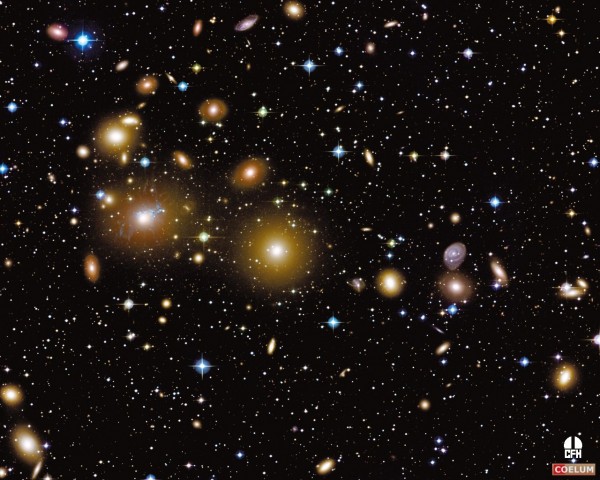
Image credit: Jean-Charles Cuillandre (CFHT) & Giovanni Anselmi (Coelum Astronomia), Hawaiian Starlight.
This is a supercluster of galaxies! Nearly 10 million light years across and containing thousands of galaxies, the Perseus Supercluster teeters on the brink of what it means to be gravitationally bound. (It is, but just barely.)
If we look to even larger and larger scales, though, know what we find?
The largest scales, where you can see filaments connecting the different-sized clusters of galaxies to one another, are not bound to one another!
In fact, we know that -- thanks to dark energy -- the farther away an object is from us, the faster it will continue to expand away from us!
But this is assuming one very important fact: dark energy is a constant.
Now, this is in excellent agreement with observations. We have measured that whatever dark energy is, it is very, very consistent with a cosmological constant, and if we want it to be anything different (such as to either increase or decrease in strength over time), there are tight constraints on how quickly it could possibly be changing.
But, to be certain, the only way is to wait for the future to unfold and see what happens. Other things are possible, even though our best measurement shows us the middle case, above, where the things currently bound together stay bound, and the things expanding away from us now will eventually disappear.
What does this mean for us, and the fate of the Universe as we know it?
This, above, is a pretty accurate representation of our Local Group. This is our little, nearby cluster of galaxies: the stuff gravitationally bound to us. Over the next few billions of years, all of these galaxies will eventually merge together, forming a giant elliptical galaxy, while the other galaxies in the Universe will continue to expand away from us at an ever increasing rate.
But, what if dark energy isn't a constant like we presently think it is? What are the other two options?
The reversal strategy -- leading to a recollapse of the Universe -- is by far the biggest stretch. Not only would dark energy need to stop doing what it's currently doing, it would need to start doing the opposite. If this were the case, we'd see galaxies accelerate away from us, and then suddenly begin decelerating, stop, and reverse direction back towards us. Not only is this observationally troubling, the only theoretical ways to make it happen are completely contrived to achieve this "Big Crunch" fate as an end result. (Are you reading this, Paul?)
But there is another possibility: that dark energy will continue to get stronger. This is a fun one to think about. (I don't think it's particularly likely, but it is one of the most interesting possibilities out there.) Let's take a look.
A cosmological constant means that the expansion rate is constant. In other words, for every Megaparsec (about 3 million light years) distant an object is, it expands away from us at about 60 km/sec. Wait until it's 30 million light years away, and it appears to move away at 600 km/s. Wait until it's 3 billion light years away, and it recedes at 60,000 km/s. (You get the picture.)
But if dark energy continues to get stronger over time, that means the expansion rate itself will continue to rise and rise, unchecked, until gravity itself is challenged.
The super-galaxy that the local group will become? As the expansion rate continues to rise and rise, the individual stars in this galaxy will start to get caught up in the ever-increasing expansion.
At first, the outermost stars -- the ones least tightly bound to the galaxy -- will be the only ones expelled. But eventually, even the innermost stars will get kicked out, leading to a Universe of scattered, expanding star systems formed from the remnants of our once-grand galaxy.
But it gets worse. The expansion rate doesn't stop accelerating just because we destroyed the galaxy. Each star system, with its planets, moons, comets, asteroids, gas, dust, and possibly multiple stars, gets ripped apart too! First the outermost objects get flung out of each Solar System, but eventually even the innermost planets are cast off into interstellar space, away from their host stars and away from one another.
And at this point, you may think, it couldn't possibly get any worse.
Are you ever in for a rude surprise.
The expansion rate will eventually become so large that everything, from stars to planets to individual atoms, will be torn apart. In the last fraction-of-a-second of the Universe, even subatomic particles will be ripped out of the atoms themselves, as the Universe ends in an unprecedented catastrophe known as The Big Rip.
Current observations disfavor both the Big Rip and Big Crunch scenarios, and find that -- to the best accuracies we can measure -- dark energy really is a cosmological constant.
But now, when someone asks you about the Fate of the Universe, oh, what a story you'll have to tell!


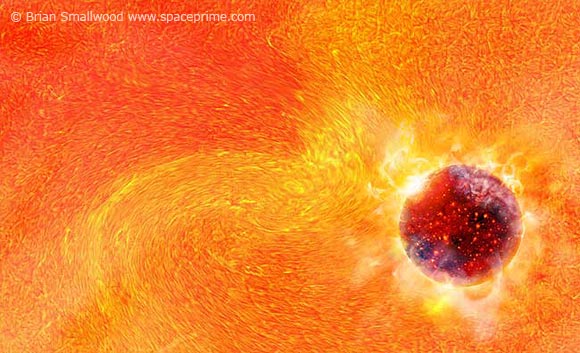
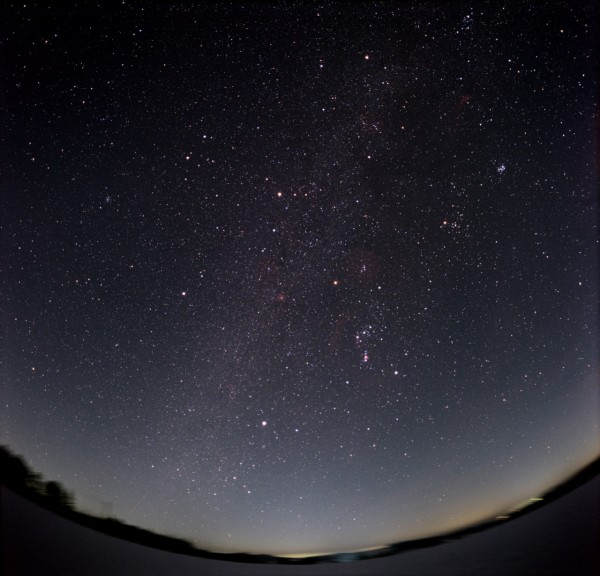
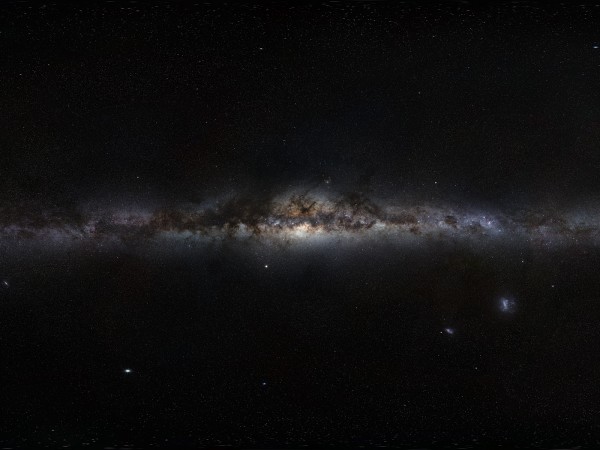
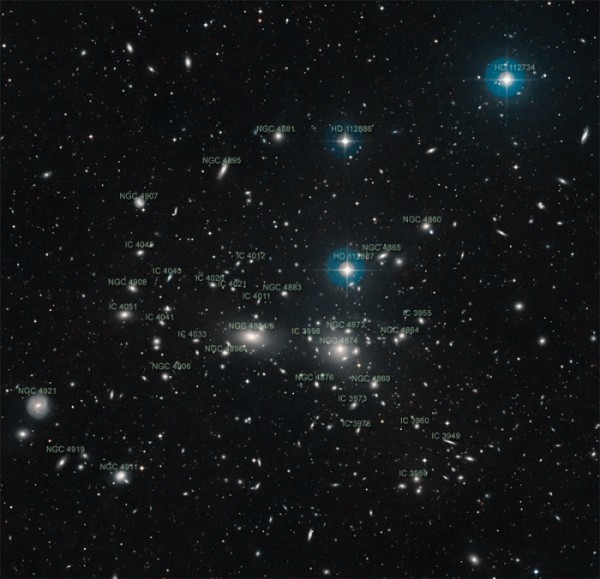
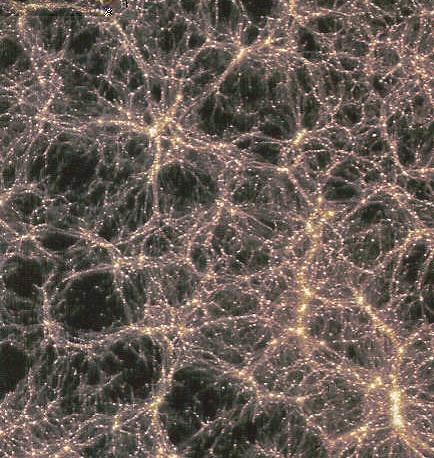
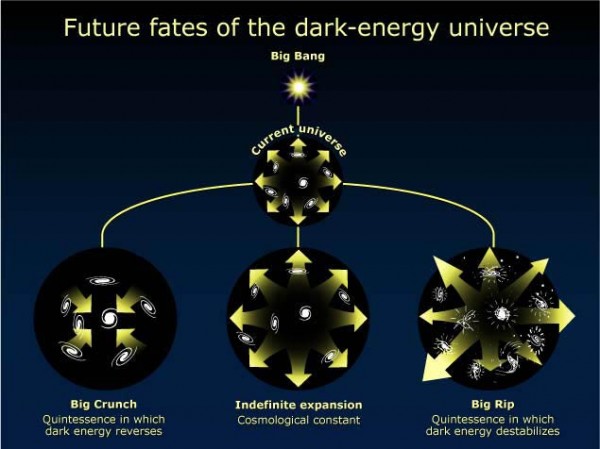
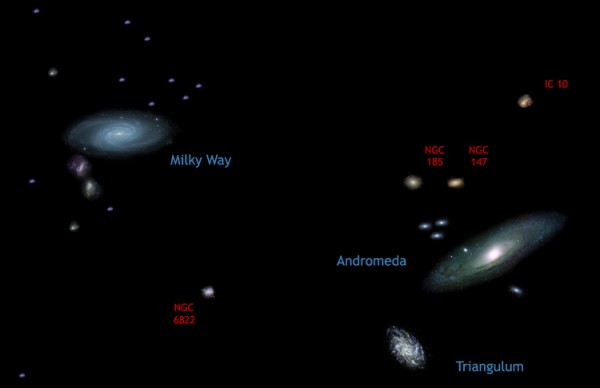
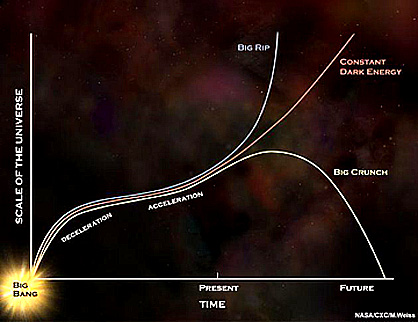
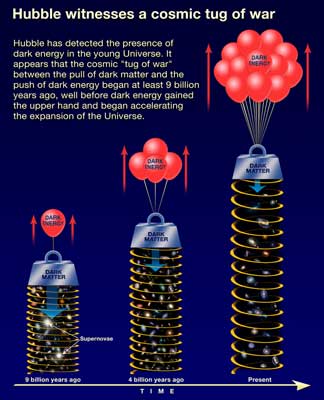
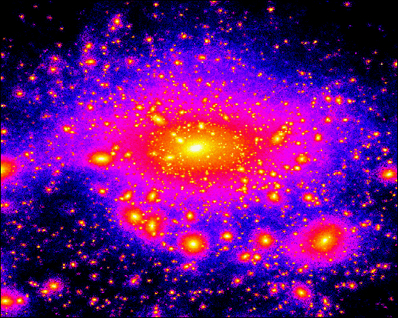
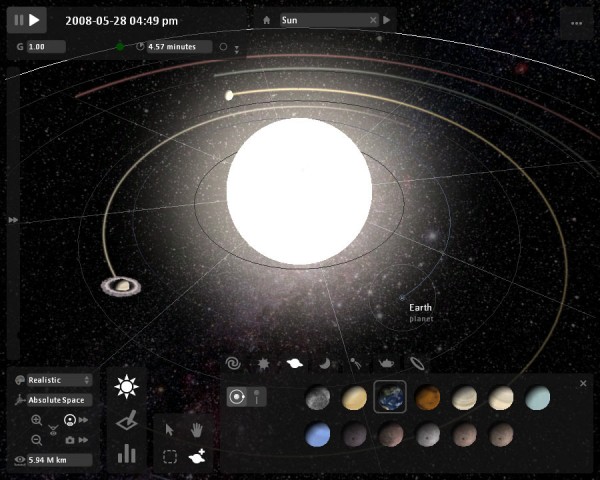
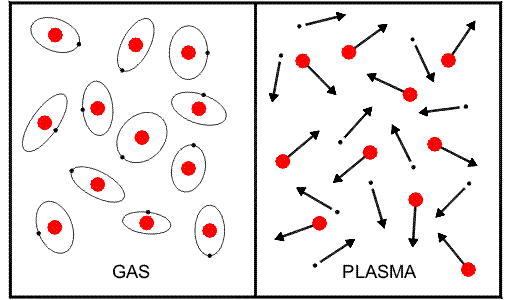
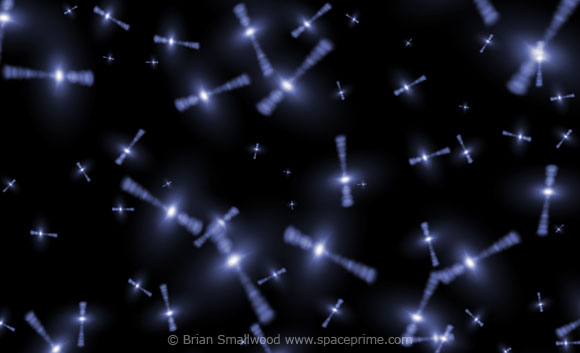
Is there any possible link between dark energy and inflation?
One word: YIKES!
Excellent post,
What if The Cosmological constant is accelerating but not enough to cause a big rip, say that Dark Energy, Dark Matter, Normal Matter, and Black Matter, are all tied together somehow other than gravity (local shape charge),more like DM and NM are catalyst for the others, the expansion of DE relies on the amount of DM, and DM is reliant on both DE and NM (NM reliant on DM and BM)etc. and the further and longer DE expands then DM responds by an ever increasing inward falling into itself only to actually unite on Universal scales with NM, and thus NM is made only to be consumed by BM and then only to be slowly dissipated by radiation, and then since there is no more structure to expand...it contracts back to the initial clumps and thus an ever expanding, ever contracting, not quite steady repeating state.
All three scenarios due to the CC being almost constant yet not extreme enough for a big rip.
Until we know exactly how DE and DM respond, I think a variant of the three can happen, eh?
For a visual image picture billions of NASA space shuttles taking off and each consecutive shuttle filled with slightly less fuel(but not enough to notice since there are so many and the fuel supply varies slightly at a constant rate)...at some point some of the Shuttles won't make orbit and will eventually re-coalesce.While some shuttles go on and on and some never leave the ground.
If the CC constant is really, really really close, yet not perfect...
I think the Big Rip singularity (like its Big Crunch counterpart) is a good reason why a constant rate is preferred.
On the scale of things though, I seem to remember that there have been signs, possibly unconfirmed, of the Local Group coming apart from DE expansion though. So the final state with a lonesome galaxy in our observable universe may have a smaller galaxy than the suggested merger of the whole group; it may be a competition between merger and sunder.
@ pjsouza:
Good question, I would like to know too!
If the cc acts on spacetime (say as vacuum energy from fields), it may act on semiclassical worldline systems as well. The later is AFAIU sufficient to extract some, perhaps all, of inflation characteristics. [Possible misunderstanding from reading a review of Linde.]
That is a potential "link" though they could still be independent. (And inflation swamps expansion big time. Or should I say Big Scale? =D)
@ SC: Now you are discussing something else than (modified) standard cosmology though, where DM and DE properties are pinned down. And I think you mean if the increase of expansion rate is accelerating, not "The Cosmological constant".
"why a constant rate is preferred." Oops, I think that should be rate of rate.
"... though ... though". Though I think the main problem is what I wanted to say that the expansion shows sign of overwhelming the earlier boundedness (that made the group cluster) even on these scales.
I've been reading your blog for months and it's one of my favorites on SB, heck on the whole web.
Your posts are educating, stimulating and delightful. Keep it up!
Sphere Coupler @ # 3: ... Dark Matter, Normal Matter, and Black Matter...
A quick Google hunt for "Black Matter" turns up a lot of articles about dark matter, plus one Q&A page where one of the answerers speculates the questioner is asking about non-reflective bodies.
My first guess was that you might be referring to matter which falls into a black hole and never comes out again (poor thing!) - which in turn raises the question of what happens to BHs in any of our esteemed host's three scenarios above, but I digress.
Just what do you mean by "Black Matter", please?
Well I was being rather general, and your right, I wasn't very clear.
The original CC predicts a static Universe.
A modified CC that incorporates cosmic inflation.
And what some now think
An accelerating cosmocon-ACC
(and some think)
an increase in the acceleration rate of the expansion rate of the original cosmocon,at a possible varying rate.
Kind of *in fits and starts* and if thats the case we will never figure that out.(as a whole)only segments.
Does that make better sense?
"Now you are discussing something else than (modified) standard cosmology though, where DM and DE properties are pinned down."
You got it!
I'm trying to couple local systems to explain the non-local system and visa/versa, for a systems within systems approach, where not only is there a system within a system but the systems couple according to their exspanding parameters. .
The word quintessence appears in one of the diagrams above. It translates roughly as fifth element or essence. The Ancient Greeks believed there were four elements (water, fire, earth and air) and space was made of the fifth element or quintessence. Why is used in modern astronomy?
Would there be any liquid water left in the oceans by the time Earth's temperature has risen, slowly, to 212 degrees? Wouldn't the planet be a mess of rock and steam and methane?
#7-Pierce R. Butler;
a not well defined form of baryonic matter under extreme pressure, curvature and density.(As far as I am aware)We only know about it's mass indirectly by NM reactions, and hypothesis.
My personal assumptions are, that a sort of standard model can be built for BM, DM as well as the NM standard Model.
Yes , normal baryonic matter on the other side of the event horizon, which we know little about it's reactions with itself under extreme curvature and density. The standard model (of normal baryonic matter)tells us a little of the configurations possible inside due to a form of the Cosmic censorship hypothesis,
whereas possibly the Top Quark Condensate model may be a better model for physics beyond and further down the color glass condensate rabbit hole.
I sense the standard model incapable to completely describe the environment inside a black hole and (I) therefore recognize a separation in types of mass and their generated families.
I think event horizons, or coupling points are a common feature in our Universe on all scales, though as mass gets less dense, the horizons or couplings are harder to define. This is the reason I think that DE is coupled to DM,NM,BM all on their own scale and intertwined between them based on amounts of mass or lack of mass and distance (predominately)
I'm probably alone in my analysis here.
So don't quote me.
#9 Brian
Quintessence is an (incomplete) hypothesis attempting to explain the Dark Energy effect of the accelerations of the Universe.
(incomplete) is my determination)
Quintessence does not work in it's current form and leads to the Big Rip and Big Crunch, as Ethan has shown in the above diagram.
Due to expansion: Shouldn't we observe disappearing and rapidly fainting away objects behind the curtain? Why don't we see this phenomenon by our surveys?
Start by looking up. Each point of light you see in the night sky is -- with the exception of the occasional planet -- its own star.
That's very interesting, but there's one unanswered burning question (at least for me). The Wikipedia entry says:
'In the last minutes, stars and planets would be torn apart, and an instant before the end, atoms would be destroyed.'
What happens _after_ the atoms are destroyed? In other words, what does 'the end' refer to? Shouldn't there be no end, only the ever increasing distances between what's left after the building blocks of atoms are destroyed? And what would happen to the space itself? Would it get ripped apart in some way too? (if it even makes sense)
Thanks.
@1 pjsouza:
Some scientists note that an ever-increasing rate of expansion (the Big Rip scenario) begins to look more and more like inflation, and posit (though as Ethan notes it's all highly speculative) the "Ekpyrotic Scenario" and "Cyclic Model" (both on Wikipedia, and as you'd see there, both with a LOT of baggage) in which, basically, one universe's Big Rip forms the "next" one's inflation, in a never-ending cycle.
Again, so speculative I doubt Ethan would even call it science, but fun to think about! :D
@14 gaijin:
Yeah, I was wondering the same thing about this being referred to as "the end". Perhaps it's just because each particle would become a universe unto itself, which implies that nothing more could ever really happen (though I can't begin to imagine what such a space-time would mean for quantum mechanics - could a virtual pair be causally disconnected before their annihilation?) but I'd love a more concrete answer, too.
@14/15: Look at the graph of "scale of the universe" to "time" above. The way cosmologists measure expansion is by appending a scale factor R(t) to distance (with R(now) = 1). Turns out, the field equations yield an ODE in R.
Solutions to the ODE give R goes to 0 as t goes to 0 (the Big Bang). But the behavior of R as t grows depends on empirical factors. In one case, R goes back to 0 (big crunch) --- not likely. In the second case, R grows exponentially (indefinite expansion). The the third case, R has a vertical asymptote. That's math-speak for "blows up in finite time," i.e., R does not exist after that time.
If R grows exponentially, all matter and energy will eventually be torn apart, but it will still exist, its waveform just infinitely stretched out and flat and cold. There will be no definite end, it will just continue flattening itself out forever.
If R blows up in finite time, the universe will cease to exist after that time. There will be an end.
Does that distinction make sense to you guys now?
Universe Sandbox is soooooooo much fun! And you can get it on Steam now. Acheivments and all!
What are the "normal matter" differences than can be astronomically observed (or potentially observed) between the present (within 2 billion years from Earth) and the early universe (between 13.7 and 11.7 billion years From Earth). I'm deliberately using time rather than distance so my meaning is clear.
1) How are present galaxies different than early galaxies?
1a) e.g. Are very early universe galaxies observed to have greater galaxy rotation discrepancy than nearer time galaxies observed? (due to hypothesized increased dark matter of early universe)
2) How are early stars (or other stellar objects e.g. quasars, black holes) different than current ones?
3) How are early filaments or voids different than current ones?
4) What are the specific actual or potential "baryon matter" observational differences that a Webb telescope or a neutrino detector or some other experiment can check out that are potentially different in the early universe than in the current universe and that can potentially be extrapolated to the next 12 billion years from now?
Here's a quick sanity check. Some quick wiki-ing suggests the Friedmann equation for the scale constant R can be written, in the limit density = 0:
R'' = (Kc^2)R. (K = Lambda is the cosm. factor).
IF K is constant, then the solution is exponential: R = exp(sqrt(K)c). Uniqueness of ODEs blah blah blah.
If K is increasing in time fast enough, or if it's proportional to R, however, then we'll get finite-time blowup. (This is similar to the equation a' = a^x. If x > 1, the solutions all blow up in finite time.)
Following your calculations objects at 15bly move away from us at about 300.000km/s which about the speed of light. So is the observable limited to exactly 15bly around us?
#11 so basically they've appropriated an ancient term that meant fifth element, but has no relation to that metaphysics?
Well sorta, The fifth element was a general term back in Plato's day also called Quintesince.
Aristotle evoked the Aether, a simular concept.
Einstien re/evoked the Aether, then took it away.
Then after this back and forth for a while They put it back because a science needs a focal point in order to progress.
(You have to have something to look for which uses all known data of the age)
Modern quintessence is a hypothetical form of dark energy postulated as an explanation of observations of an accelerating universe.
Let me give you another example of this required focal point.
The Higgs Boson is a focal point, it seems to match the data of the up to date knowledge that has been aquired, yet this does not explicitly mean that a Higgs Boson will be found, it is a focal point for progression towards understanding the Higgs Mechanism.
The Higgs Mechanism can have numerous possibilities other than a simple and blatent Higgs Boson.
You must have the focal point, We know from emperical observation that there is *something* driving the Universe and your question has highlighted the process in which we as humans go about trying to understand what we observe.
Does that help?
Wow, OKThen,
such a plethora of questions, good questions that is, I have attempted to formulate several responses today in between other work but unfortunately I am a bit under the weather at present, I haven't the strength or time *yep an excuse* yet the questions are so varied I doubt that I could give any of them justice right now, so don't think I'm disregarding, I just can't get to it right now, though your questions and conversation previously held are telling of your interest in time modification, I admire your fortitude and desire to search for a quantised time.
I do think your goal and mine will cross paths...someday.
Keep up the research and inquiries of your goal, it is a noble pursuit.
Look back to some of Ethans post, there is a wealth of info there and be sure to recheck Wiki, cause it is always being updated and refined.
I will try to come back to it.
Physicists in general like to appropriate ancient Greek terms for modern concepts which are (in a very broad sense) similar. The atom itself is an example of this.
Due to expansion: Shouldn't we observe disappearing and rapidly fainting away stars/galaxies, which reside near the boundary of the observable universe? Why don't we see such phenomenon between sky surveys?
"Why don't we see such phenomenon between sky surveys?"
It takes a long time for a star to move a light year. And the redshift change for one light year is undetectable. A billion light years is doable, but then that would take even light a billion years to travel.
@26:
...but objects so far away already 'have' sent their light to us long ago, reaching us 'now'. And such objects 'expand' very fast from us. Thus for them we should recognize a high gradient in getting fainter and at the next survey even vanished...
Where is my error?
The timescale between sky surveys is simply too small to detect any fainting. The universe is expanding, but it's SO HUGENORMOUS that everything not within a couple of parsecs of us -appears- to be frozen on the scale of human civilization.
SphereCoupler
Thanks.
Your fifth element, aether, Higgs discussion makes the very good point that science needs a focal point. Thank you for that explanation/insight; nice.
I recently came to a similar conclusion regarding dark matter. That whether the dark matter hypothesis finally is the correct explanation of the dark matter observations is not important. The dark matter hypothesis has been and continues to be one of the most productive physics hypothesis in that it motivates a great deal of theoretical, experimental and observational physics work in a way that the alternative hypotheses (even if correct) do not. i.e. in your terms dark matter is a focal point.
@16
Yes, that does make sense. Thanks!
@16 and @30
Of course a mathematical infinity (e.g. "R blows up in finite time")is not necessarily a physical possibility. A mathematical infinity may indicate an incorrect physical assumption and suggest experiments to break or validate acurrent theory.
Galatasarayâda 3. Fatih Terim dönemiyle ilgili artık resmi bir açıklama yapılması beklenirken, Les Ottomans Oteliânde Ãnal Aysal ve Ali Dürüst ile biraraya gelen tecrübeli hocanın takımla ilgili düÅünceleri de belli oldu.
GörüÅmeyle ilgili Ali Dürüst, âGalatasaray sohbeti gerçekleÅtirdikâ dedi
this dark energy might be where Life all started from, only time will tell
Why will the sun become hotter in 1-2 billion years before hydrogen is consumed? Googling gives me post hydrogen articles (4-5 billion years) and solar cycle articles (11 thousand years). I think I am about to learn something new - if you reply :-)
Surya, the conversion of hydrogen to helium means fewer loose particles, as it were, within the sun's core, which means slightly less pressure, which allows the sun's core to contract. The contraction turns some potential (gravitic) energy into heat energy. Also, then the pressure would rebuild from being in a contracted state, allowing more collisions (I think). It's very slow, but stars do gradually contract and heat during their mainline life.
We'll probably all nuke ourselves long before any of this happens. I don't really believe in the big crunch theory either. Unless someone has seen a Universe go into a big crunch before it pretty much has never happened so I have no reason to believe that it will.If dark energy or matter is filling in the Universe then how can it collapse on itself?